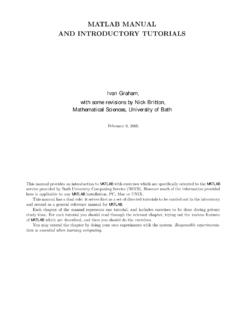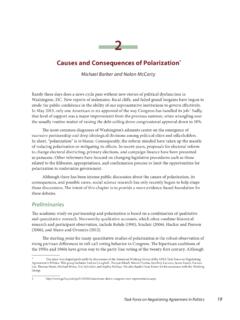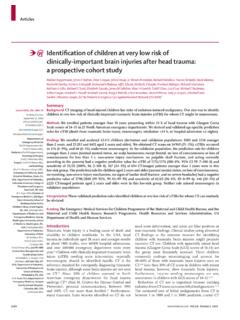Transcription of DO GLOBAL WARMING AND CLIMATE CHANGE REPRESENT A …
1 DO GLOBAL WARMING AND CLIMATE CHANGEREPRESENT A SERIOUS THREAT TO OUR WELFAREAND ENVIRONMENT? by michael E. MannI. IntroductionThe subjects of GLOBAL WARMING and CLIMATE CHANGE have becomeparts of both the popular lexicon and the public discourse. Discussions ofglobal WARMING often evoke passionate responses and fierce debate betweenadherents to different views of the threat posed. Yet there are many nuancesregarding GLOBAL WARMING , CLIMATE CHANGE , and the threats they representthat are not well understood by the public.
2 The public s conceptual under-standing hinges largely on images and paradigms within the popularculture that are often little more than caricatures of the actual, underlyingscientific concepts. To appreciate the potential threat that CLIMATE changeand GLOBAL WARMING REPRESENT to human society, living things, and ourenvironment, it is necessary that we first understand the true scienceunderlying these purpose of this essay is to assess the implications of CLIMATE changefor the welfare of human society and our environment.
3 I will first discussthe science underlying GLOBAL WARMING , CLIMATE CHANGE , and the connec-tions between these two phenomena (Section II). I will then explore whatclimate changes are projected for the future under various plausible sce-narios of future human behavior (Section III), and what impacts thesechanges are likely to have on society, ecosystems, and our environment(Section IV). Finally, I will consider the economic, security, and ethicalconsiderations relevant to evaluating the threat of CLIMATE CHANGE (Sec-tion V) and the steps that should arguably be taken to mitigate climatechange and its impacts (Section VI).
4 I will summarize my conclusionsSection Scientific BackgroundGlobal warmingrefers to the phenomenon of increasing average surfacetemperatures of the Earth over the past one to two centuries. The conceptis related to the more general phenomenon ofclimate CHANGE ,which refersto changes in the totality of attributes that define CLIMATE not only sur-face temperatures, but also precipitation patterns, winds, ocean currents,and other measures of the Earth s CLIMATE . For this reason, I will favor 2009 Social Philosophy & Policy Foundation.
5 Printed in the of the more general term CLIMATE CHANGE throughout this essay,recognizing that GLOBAL WARMING is simply one of the attributes of climatechange. CLIMATE CHANGE can be viewed as consisting of two components,one of which is human ( , anthropogenic) in origin and coincides intiming with the industrial period of the past two centuries, and the otherof which is natural and has played a role in both past and current climatevariability. GLOBAL WARMING generally refers to the anthropogenic com-ponent of CLIMATE CHANGE alone, and only the surface WARMING associatedwith it.
6 The key scientific issues required to understand the behavior ofthe Earth s CLIMATE system are discussed below, and include the notion ofenergy balance,which governs how the CLIMATE system works, thegreen-house effect(including the special case of theenhancedorhumangreen-house effect), which is necessary to understanding surface temperatureson Earth, and so-calledfeedbacks,which can amplify the magnitude ofclimate changes. Other essential aspects of the science of CLIMATE changeare the construction and use of theoreticalclimate modelsto investigate thebehavior of the CLIMATE system, an understanding of the factors that havegoverned past CLIMATE , and, finally.
7 The inferences that can be drawnthrough a comparison of model simulation predictions and available obser-vations in the assessment of the human impact on Energy balanceThe average surface temperature of the Earth is maintained by a bal-ance between incoming and outgoing sources of energy or radiation. Theincoming energy is in the form of solar radiation, some of which takes theform of the visible light that we see from the sun, but much of which isin invisible forms of electromagnetic radiation such as ultraviolet radia-tion.
8 Some of the incoming radiation scatters off the molecules of ouratmosphere, giving us, for example, the blue skies of Earth rather than thestark black skies of the moon or planets without an atmosphere such asMercury. The outgoing radiation is of a very different form than theincoming radiation. The wavelengths of radiation produced by the rela-tively cool Earth are longer than those produced by the relatively hot sun,and such radiation is invisible, falling outside the frequency band ofvisible light.
9 This radiation is primarily in the form of so-called infraredenergy, which we typically associate with every 100 units of incoming solar radiation, roughly 30 parts arereflected back to space by either clouds, the atmosphere, or reflectiveareas on the Earth s surface. This reflective capacity can vary over time aschanges occur in the spatial extent and distribution of reflective surfacessuch as clouds and ice cover. The remaining 70 units that are not reflectedare absorbed by either the atmosphere, clouds, or the surface.
10 To maintaina steady temperature or equilibrium, the Earth s surface and atmospheremust emit the same amount of radiation that they receive from the E. MANNThus, the Earth must emit that same quantity of 70 units of radiation backout to space, but this time in the form of invisible, infrared radiation asdiscussed the amount of radiation produced by a body, such as theEarth s surface, increases as a function of the temperature of the body,that 70 units of radiation determines, in turn, the surface temperature ofthe Earth.








